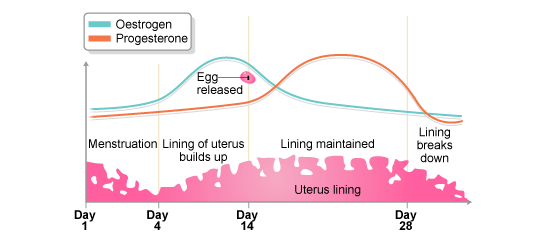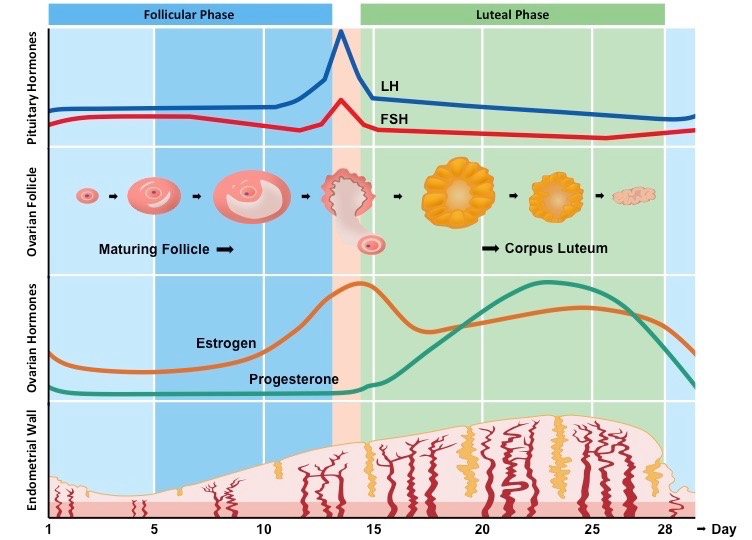Animal and Plant Hormones
Puberty and the Menstural Cycle
Menstrual cycle
You need to know about the four hormones that are involved in the menstrual cycle:
- Follicle stimulating hormone (FSH): this hormone causes an egg to mature in one of the ovaries. This is produced in the pituitary gland.
- Luteinising hormone (LH): This hormone stimulates the release of an egg at 14 days. This is called ovulation. This is produced in the pituitary gland.
- Oestrogen andprogesterone: These hormones tell the uterus lining to grow or deplete (more on this later). These are produced in the ovaries.
The levels of these four hormones fluctuate throughout a cycle.
- FSH causes an egg to release in an ovary and stimulates the production of the oestrogen hormone.
- Oestrogen causes the lining of the lining of the uterus to grow and stimulates the release of LH.
- LH stimulates the release of an egg (this happens at day 14). The pituitary gland also inhibits (stops)the release of FSH.
- Progesterone is produced in the ovaries and consists of the remains of the follicle after the egg had been released. This maintains the lining of the uterus throughout the last half of the menstruation cycle. Progesterone inhibits the release of LH and FSH. When progesterone concentration drops, the lining breaks down and LH and FSH are no longer inhibited.
Contraceptives
Oral contraception
Benefits:
- Easy to use
- Over 99% effective
- is thought to reduce the risk of certain types of cancer
Problems:
- It’s not 100% effective
- Can cause some side effects, such as irregular periods, headaches, fluid retention
- It doesn’t protect against STDs
For these reasons, a lot of people use oral contraception along with barrier contraception.
Barrier methods
These are techniques which prevent pregnancy by stopping sperm from ever reaching the egg. They include male and female condoms.
They are not 100% effective and can break. However, they do protect against STDs (if not broken).
Increasing Fertility
Increasing fertility
Women can take hormone drugs in order to help stimulate egg release. However, these methods may not always work and they could stimulate too many eggs to be released.
In vitro fertilisation (IVF)
- Women are given hormone drugs in order to stimulate egg release
- The eggs are collected from the woman and transported to a lab.
- The eggs are fertilised in the lab with the man’s sperm.
- The fertilised egg is left in an incubator to grow into embryos. Embryos are small balls of cells.
- Once the embryos have matured, a couple of them are transferred into the woman womb for natural growth.
Pros of IVF:
- This allows people the chance of getting pregnant when they may not be able to otherwise.
Cons:
- IVF is expensive
- Success rate is low
- multiple births can happen since more than one embryo is transferred into the womb to increase the chance of pregnancy.
- The process is mentally and physically stressful for women.
Plant Hormones
Plants need to be able to detect a changes in the environment in order to survive. This includes sensing which way is up (so that they don’t grow into the earth) and changes in light intensity.
Auxin
Auxin is a plant hormone that controls the growth of plant roots and shoots by stimulating or inhibiting cell elongation.
Auxin is sensitive to two things:
- Light
- Gravity.
Auxin works in different ways depending on whether it is in the roots or the shoots of the plant.
Plant shoots
Plant shoots need to grow towards the sun (or the area with highest light intensity) and grow in the opposite direction of gravity (grow upwards).
- Shoot auxin gathers in the shade - this causes the shoots to curl and grow in the opposite direction, towards to light.
- Shoot auxin accumulates at the bottom on the shoot - this causes the shoot to curl and grow in the opposite direction, away from the direction of gravity (up).
Plant Roots
Plant roots need to grow downwards. Root auxin stops cell elongation.
- Root auxin accumulates at the bottom on the shoot - this causes the shoot to curl and grow in the same direction, towards the direction of gravity (down).
Uses of Plant Hormones
Auxins
Killing weeds
Auxins can be used that affect the growth of broad leaved plants (most weeds) but don’t affect the growth of narrow leaved plants (grass).
Growing plants from cuttings
If cuttings from a plant are just placed in the ground, it is unlikely that they will grow quickly. If you put rooting powder (containing auxins) with the cutting, the auxins will promote cell growth and the plant will grow rapidly.
Growing cells in tissue culture
Clones of a plant can be made by taking a sample of plant tissue and growing this. The tissue will start to grow if auxins are added.
Gibberellins
Gibberellins are another type of plant hormone. they stimulate stem growth, flowering and germination of seeds.
- __Controlling dormancy __- Many seeds don’t germinate until they’ve been through a series of certain conditions. This is to make sure that plants don’t start growing in winter and quickly die. Gibberellins can be used to germinate seeds all year round.
- Inducing flowering - Many plants need to go through certain conditions to flower (certain levels of water and sunlight). Gibberellins can be used to induce flowering all year round.
- __Growing larger fruit __- Gibberlines can be used to promote growth in plant and berries.

